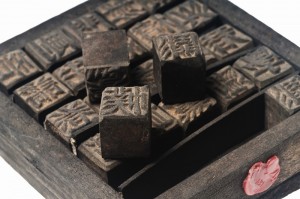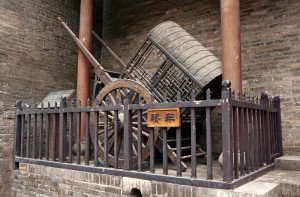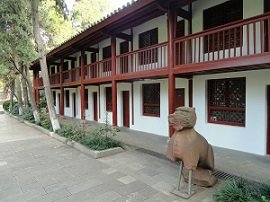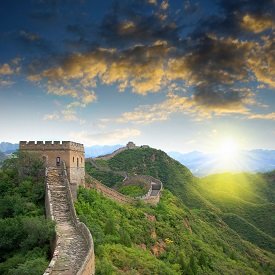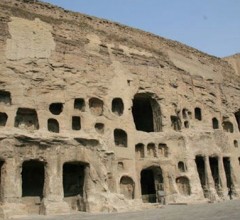Part II – Creation of a Classic, Bureaucratic Empire: Qin Dynasty, 221 – 206 BCE – Han Dynasty, 206 BCE – 220 CE
- Introduction
- Qin Dynasty 221-206 BCE – Unification, Legalism, Bureaucracy, The Great Wall
- Han Dynasty 206 BCE-220 CE – Confucianism, the Mandarinate, and Northern Nomadic Barbarians
- Confucianism
- Mandarinate – China’s Imperial Examinations and China’s Civil Service System
- Chinese Historical Records
- Patriarchal Society
- The Past in the Present – Themes of Early Chinese History in the Modern Age
- What Happened Next?
Introduction
The end of the Zhou Dynasty, with its decline into the Warring States Period, was a chaotic and violent time. Seven states vied for power across the empire. This government fragmentation ended with the victory of the Qin, resulting in a brief, but hugely important, period of unity for the Chinese. The Qin empire bears much resemblance to the China that we see today and its first emperor, Qin Shihuang, is credited with instigating construction of the Great Wall and the Grand Canal. The successive dynasty, the Han, continued the fight with nomadic peoples from the northern frontiers and established crucial trade links through the famous Silk Road. It also underwent a crucial intellectual battle between Confucianists and Legalists that helped to define what we consider to be Chinese culture today.
Qin Dynasty 221-206 BCE – Unification, Legalism, Bureaucracy, The Great Wall
The period before the establishment of the Qin Dynasty was a time of political fragmentation. By 403 BCE, seven major states were all vying for power within what would eventually become known as China (the name China originated from an early Romanization of Qin which was written ‘Chin’.) The Qin state originated on the western edge of developed China. Unlike with other powers within China, this meant that the Qin state was not boxed-in on all sides by competing fiefdoms. This allowed it to expand its territory more easily, incorporating an increasingly large population under its jurisdiction. It was also more open to social, political and cultural innovations, and readily used talented men from other states.
Because the Qin did not enter the feudal domain of the Zhou Dynasty until the reign of Xiang (777-766 BCE), several centuries after the more established states, and because of its North Western location, the Qin was viewed by the other fiefdoms as a less civilized and more barbaric state. Xiao of the Qin (361-337 BCE) was determined to change this image and increase the Qin’s standing in the world. Influenced by the thoughts of Shang Yang, a Legalist reformer, (350-338 BCE) Xiao implemented a largely Legalist style of rule in his domain. Realized Legalist doctrines included promoting by merit as opposed to by noble birth, and the creation of a strict set of laws which applied to all people equally. Written on stone, these laws were sent to all parts of his kingdom. He allowed peasants to buy and sell land, and implemented widespread irrigation projects which resulted in increased agricultural production. This production was taxed fairly to encourage further agricultural development. The resulting wealth gave the Qin the food and economic resources necessary to launch military offensives. By 256 BCE, the Qin conquered the state of Zhou, bringing the Zhou Dynasty to an end. By 221 BCE, the Qin had conquered all seven Warring States, marking out for the first time the beginning of the geographic scope that would become of Chinese nation.
The Qin leader Zheng, and his chief minister Li Si, led the final Qin charge to vanquish the competing fiefdoms and unify China. Since no previous royal titles – such as King or Duke – were sufficient to describe the scope of the Qin leader’s enormous power, a new title was devised: Huangdi, meaning ‘august god’, a term that invoked the image of the Yellow Emperor, a legendary Chinese sovereign and cultural hero presented in Chinese mythology whose name had the same pronunciation in Chinese. China’s first emperor was better known by his full title of Qin Shihuang. He followed Li Si’s advice not to make his sons and relatives the kings of the various conquered territories, but to staff them with military and administrative professionals. The Qin leaders then forced 120,000 of the most wealthy and powerful aristocratic families of all the conquered states to move to the Qin capital of Xianyang, just outside modern-day Xi’an, where they were far from their power bases and could be easily watched. Qin Shihuang also had the nobles’ weapons melted down and recast into two large bells and 12 enormous statues which were then placed on his palace grounds.
The government was centralized, and the entire Qin kingdom was divided into 36 large administrative units, each of which was further divided into several counties. Each was governed by a civil officer, a military officer and an official inspector who independently reported to the central government. All people in the Empire were graded into a system of 20 non-hereditary ranks where individuals could better their status, essentially go up in rank, with accompanying rights to land, titles, tax remissions and slaves, through military accomplishment and meeting or exceeding agricultural production quotas. The Qin also had the novel idea of organizing families in groups of five or ten. Each family group was responsible for the behavior of all its members so that, if any group member committed a crime, all were held responsible, thus engaging the entire population in policing.
Early on, the Qin administrators realized that maintaining Qin supremacy required a strict husbanding of its human, military, and natural resources. In order to achieve effective accounting, weights and measures, the axle lengths of chariots and carts, and Chinese character writing styles were standardized. Retaining local forms of currency, weights and measures, or writing scripts was made an act of treason and the Qin currency was introduced nationally. Infrastructure projects were a key facet of the dynasty and 4250 miles of roads were built throughout the empire. The Grand Canal was begun, built by thousands upon thousands of conscripted laborers. Conscripted laborers also connected many parts of earlier state walls which extended along almost 4000 miles of the northern border of the empire. This extended wall was eventually to become known as the Great Wall of China.
The Chief Minister Li Si contended that as Qin Shihuang had unified all of China, he had also formed a single source of authority. Dissenting opinions based on classical scholarship were thus a threat to his authority. To prevent this threat, Li Si recommended the infamous Qin bibliocaust, where Qin Shihuang decreed that all historical records, apart from those of the Qin, be burned, along with all copies of the Book of Odes (the earliest existing Chinese collection of poems and songs) and the Book of Documents (a compilation of documentary records of the ancient history of China.) Books concerning forestry, medicine, or divination were exempt. Anyone caught even discussing such books risked execution. Similarly, anyone who disparaged the present by citing ancient precedents also chanced execution, together with all family members. Scholars today believe that the bibliocaust was not as devastating as first thought and many imperial libraries endured intact. Scholars also tended to memorize texts such as the Book of Odes so that textual versions could be constituted from memory and, in the next dynasty, Emperor Wu initiated an empire wide recovery of the ancient texts. In addition to burning books, the emperor also encouraged the eradication of many local traditions of all varieties. Qin Shihuang’s successes resulted in large part from his efforts to manage the detail of government himself. For instance, he set quotas as to the weight of documents he would read each day, not stopping until he completed the paperwork. The disadvantage of his prodigious work effort was that the institutions he had created to concentrate power in the hands of the monarch made the government’s strength and stability dependent upon the authority and character of the occupant of the throne.
Qin Shihuang died unexpectedly in 210 BCE. Having quarreled with his eldest son, the succession to Emperor was not clearly delineated. The eunuch Zhao Gao encouraged a younger, favorite son Hu Hai to usurp his brother for the throne. In order to prevent challenges to his rule, Hu Hai instituted a reign of terror in which he took the already legalist excesses of his father’s reign to new heights. These included a zero tolerance for criticism, severe laws and punishments, and the ruthless mobilization of laborers for construction projects. Historians have argued that the people would have accepted Hu Hai if he had made even moderate attempts to reform his father’s excesses. Instead, he implemented a harsh rule, multiplying laws and the severity of punishments, increasing taxes and executing chief ministers of state, imperial princes and palace attendants.
The hungry, indicted and exploited became so numerous that the rebellion of one man was enough to cause the entire nation to join him. The first revolt began in 209 BCE. By 206 BCE, the Qin dynasty ended with the suicide of the Second Emperor and the break-up of the Qin Dynasty. Qin Shihuang built a lavish tomb with more than 8000 life-sized terracotta warriors and 130 chariots with 520 horses and 150 cavalry horses. The Xi’an tomb was discovered in the 1970s by peasants digging a well and it has since become a UNESCO heritage site and one of China’s premier tourist attractions. Archaeological excavations at the tomb have shown that the Qin dynasty had continued the Zhou expertise in advanced metal casting technology, especially in metallurgy. Bronze swords were made with a high tin content, resulting in blades of significant sharpness and hardness. The blast furnace technology used to make this high-quality bronze was not employed in Europe for another thousand years.

Han Dynasty 206 BCE-220 CE – Confucianism, the Mandarinate, and Northern Nomadic Barbarians
When the First Emperor of the Qin died in 211 BCE, Qin Dynastic rule rapidly disintegrated. Liu Bang, already head of the Han State in 206 BCE, declared himself the Emperor of the Han dynasty in 202 BCE. The Han is the name of the dominant ethnic Chinese group who form around 92% of the present-day population. Liu Bang was one of only two known emperors of China to come from a peasant background, defeating Xiang Yu, a brilliant aristocratic general. When Liu Bang died in 195 BCE, Empress Lu, the mother of the first heir to the throne, managed to control the court until her death in 180 BCE. Despite ruthless ambition, she proved a competent ruler. She realized that the average peasant needed time to regroup after the civil war, so she fashioned government policies that encouraged people to work on the land. Food and clothing became plentiful again. She also successfully defended the frontier from nomadic invasion. Despite these achievements, Empress Lu was cited by Confucian historians as an example of what happens when women get close to power. Confucians felt that a woman’s place was in the home, obedient and subservient to the male household members.
Attack from nomadic people of Central Asia provided a constant challenge for the Han Dynasty, especially in its early years. The Xiongnu nomads led successful raids within China despite the presence of the Great Wall. Although the Wall covered large parts of China’s northern border, it was never fully connected. The nomads were superior to the Chinese on horseback, especially when shooting, thus making themselves formidable adversaries. The Han Dynasty tried to avoid war by sending the Xiongnu nomads lavish gifts such as gold, grain, and Han brides, which proved to be an expensive and relatively short-term fix. This threat of invasion from the nomad tribes of the north was a constant theme throughout much of Chinese dynastic history. The Chinese tried many strategies to solve the barbarian problem including military domination, bribery, diplomatic relations, intermarriage, and the construction of the Great Wall. None was wholly effective.
In 145 BCE Han Wudi became Emperor and ruled over China for more than 50 years. He improved the army, adopting many of the noamds’ horsemanship and archery techniques, and he increased the dynasty’s stock of horses. In 134 BCE, Han Wudi struck against the Xiongnu nomads, driving them far into central Asia. In the areas that he secured, trade flourished over a whole network of routes that collectively became known as the Silk Road. The Han Dynasty also got access to some of the central Asian grasslands which allowed it to support enough horses to maintain military advantage. Otherwise, China’s geography south of the Mongolian grasslands – dry deserts, steep mountains, cultivated river valleys – provided little open range necessary for the large scale raising of horses.
With the nomadic problem temporarily resolved, Han Wudi worked to improve the administration of his dynasty. Many Chinese dynasties were debilitated by power struggles between the Empress Dowager (the title given to the Emperor’s mother) and family, Confucian bureaucratic officials, military commanders, and court eunuchs; the Han proved no exception. Han Wudi thus worked to curtail the power of his in-laws, Confucian scholar advisers, and eunuchs. He also created central government run monopolies on the production of salt, iron, copper, bronze, and alcohol, which significantly increased state revenues depleted by the nomadic wars. The greater wealth of the dynasty partly contributed to the proliferation of Chinese inventions during this time, including standardized weapons with replaceable parts, the earliest known use of the crank, calipers so precise that they could measure distance with precision to one thousandth of an inch, sophisticated bellows which delivered pressurized air in controlled quantities to heat fires used for metal working, crop experimentation to raise agricultural productivity, the wheelbarrow and rudimentary scientific medicine.
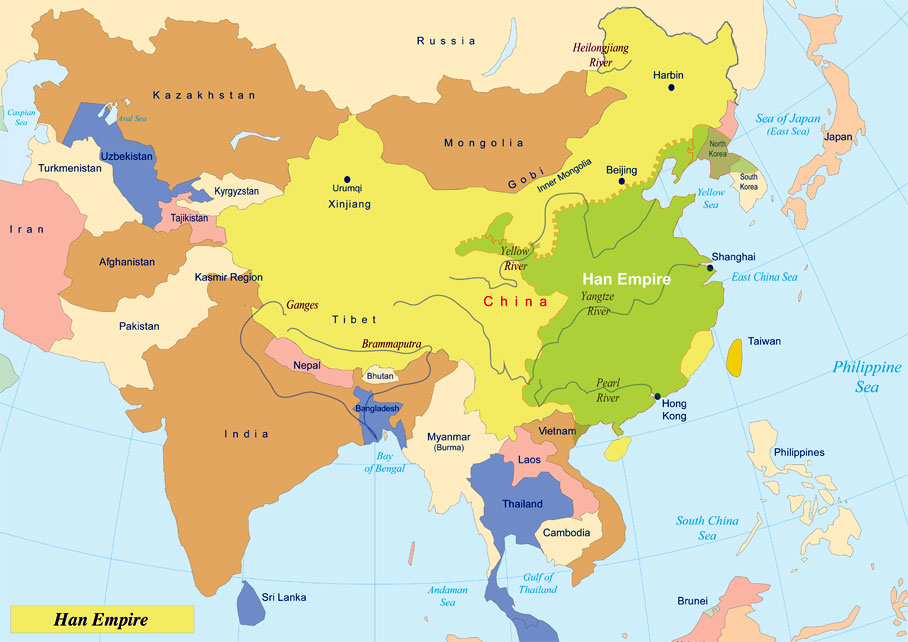
Confucianism
Although Legalist in many ways, Emperor Han Wudi established Confucianism as state doctrine. As a peasant, Liu Bang had received little education. Initially, he had little tolerance for Confucian scholars who underscored the importance of ancient history, institutions, and rituals. Yet, once he became Emperor, Han Wudi began to appreciate the utility of Confucian learning. In the early days of his court, stories are told of how many of his soldier-officials became involved in brawls within the palace walls; one was even caught hacking away at a wooden palace pillar with his sword. His advisors, steeped in Confucian traditions, established simplified court rituals which created an expectation of decorum within the court, and gave dignity and honor to his role of emperor.
Mandarinate – China’s Imperial Examinations and China’s Civil Service System
Emperor Han Wudi’s advisors argued that one of the reasons that the Qin dynasty had failed was because it had emphasized military conquest, strict laws, and a system of rewards and punishments – Legalist practices – at the expense of creating a moral and civil society. The Emperor’s advisors argued that foundation of the Han State’s morality should be the wisdom of the ancients, and that those schooled in ancient and historical wisdom should run the Han state’s bureaucracy. The Han Dynasty thus put into effect the Chinese public civil service known as the mandarinate, arguably one of the most enduring and successful instruments of administration mankind has ever created.
Acceptance into the mandarinate was dependent on passing official examinations based on the Confucian classics. These classics promoted an optimistic view of humanity. They argued that man, with the right instruction and example, was capable of constant improvement and high moral righteousness. The Han Dynasty became a leading sponsor of Chinese art, scholarship and values. The court also put into effect complex Confucian rites and rituals which had initially been introduced to tame the soldier-officials. The repetition of these rituals tried to capture the idea of an ordered, harmonious universe which continued unchanged forever. The Han emphasis on promotion by education and merit created a relatively flexible society. For example, the Confucians scholars looked down on trade, deeming that it did not adequately incorporate true moral values. Nevertheless, merchants were often able to use their acquired wealth to assure that their sons received the tutoring necessary to pass the classical scholar exams of the government officials. In this way, a merchant family could rise on the achievements of its sons. This emphasis on education was facilitated by the invention of paper in 100 CE.
Chinese Historical Records
The Historical Records of Sima Qian was written during the Han Dynasty and deeply shaped the way in which the Chinese perceived their past and thus themselves. An epic work in 130 chapters, The Historical Records explains history from many perspectives: a chronological narrative of political events; informative accounts of key institutions; and biographies of important individuals. The Historical Records set the prototype for the government-sponsored histories compiled by later dynasties. The composites style-with political narratives, treatises and biographies- became standard. By writing so well and so much, Sima Qian significantly influenced Chinese thinking on everything from government to the best conduct of individuals. For instance, in telling biographies, Sima Qian selected incidents in an individual’s life that showed consistency of a person’s character and how well the person performed a role, rather than turning points in personal development.
Patriarchal Society
Chinese dynastic society was to remain patriarchal throughout the ages. The subordinated position of women was supported by Confucian beliefs which argued that a woman’s rightful place was within the home. On occasion, however, some women rose to power and influence. The most famous female scholar in all Chinese history, Ban Zhao, lived in the Han Dynasty. Ban wrote many poems, helped her brother finish a history of the Han Dynasty, and authored Precepts for my Daughters, an instruction booklet for women that has remained well known to this day. The importance placed on filial piety also meant that emperors were often obliged to consider their mothers’ wishes, even after adulthood, giving the Empress Dowager the opportunity to exert considerable influence at Court. The Han Dynasty saw China’s population expand to approximately 60 million people, the equivalent of the Roman Empire at its height. This population lived within a wide-ranging market economy. Trade between regions was one factor which unified China into an integrated whole. Yet, much of this wealth remained concentrated in the hands of the scholar-officials, most of whom came from the old feudal families. The average Han peasant was still desperately poor.
The Past in the Present – Themes of Early Chinese History in the Modern Age
As China moved from the Warring States period into the Qin Dynasty, many of the broad themes of Dynastic China were clearly emerging. One such pattern was the alternating fragmentation and unification of the empire, where imperial control of China was periodically disrupted by the rise of regional powers which led to China being shattered into smaller competing states. Yet these fragmented states remained remarkably cohesive culturally, organizing themselves around fundamental beliefs that formed the essence of Chinese civilization. A key belief was that the family was the basis of Chinese society, and the state was an extension of the family. Ancestor worship and the wisdom of the past were to serve as a guide to the present and to the future. Meritocracy also emerged as a strong theme. Increasingly, bureaucratic officials and military leaders were promoted based on skill rather than birth right. Education to achieve opportunity became an ethos of Chinese society, creating a certain social mobility. Religion was gradually becoming bureaucratized and ritualized.
Early on, great attention was paid to agricultural productivity. The Chinese bureaucracy mobilized its masses to construct irrigation and land clearing projects. This created a feedback loop, where increased agricultural productivity led to a rise in population, requiring further engineering and agricultural innovation to maintain China’s swelling numbers of people. China’s constant battle to feed its population has echoes in the struggles of the twentieth century, while the relative size of its population in comparison with global totals also has stark parallels.
By the end of the Han Dynasty, the themes of Chinese civilization were becoming increasingly engrained, and Confucianism became firmly established as the guiding state doctrine. The Emperor’s wishes were carried out by a bureaucratic government staffed by the best-educated scholars whose places were achieved by examinations in ancient Chinese wisdom. These exams created notable social mobility and reinforced the optimistic belief of humans’ capacity for constant self-improvement through self-cultivation. Today, educational achievement remains an important avenue of social mobility. Competition for university and other academic places is brutal. In 2018, for instance, approximately 9.75 million students took the Chinese National College Entrance Examination, and about 81% were accepted.In recognition of the importance of these exams, construction sites across the country were ordered to suspend works to create a peaceful environment for the exam-taking students.
A belief in human ingenuity and its ability to positively impact the physical world and to solve problems continued as a core Chinese tenet. This is exemplified by its extraordinary engineering feats such as the construction of large parts of the Great Wall of China and digging of the Grand Canal which required the mass mobilization of conscripted labor. The educated started to see that natural laws resulted from “scientifically-explained” physical forces, not just caused by the whims of divine power. Human ingenuity was able to solve problems such as river flooding and irrigation resulting in high agricultural productivity which in turn allowed for the expansion of the population. This ingenuity also led to much technological development. Today, China continues the tradition of using engineering to solve its developmental problems. China has been laying down infrastructure at a breakneck rate as well as undertaking monumental ventures such as the South-North Water Transfer Project. The South-North Water Transfer Project is diverting water from the Yangtze River to the Yellow River in order to solve the North’s water shortage challenges. At an estimated current cost of $79 billion, the aqueduct is one of the largest and most expensive engineering projects ever undertaken.
Many Legalist themes continued throughout the Han Dynasty, including the promotion of soldier-officials based on merit as opposed to noble birth, the institution of a strict rule of law, a focus on agricultural production in order to maintain a large military structure, a fair taxation of production in order to maximize agricultural yield and the standardization of everything from axle sizes to weights. Each of these measures was employed in order to improve economic productivity which could then be marshalled to increase the power of the state. Today, the Chinese leadership still believes that authoritarian political control is the best way to create prosperity and stability for its 1.3 billion citizens. The Qin collectivization of families who were then responsible for self-policing, and the Qin effort to establish itself as the source of intellectual authority foreshadowed efforts of the Communist era.
Mass mobilization of its population to achieve often unparalleled engineering feats remains a Chinese competitive advantage. In the late 1990s, the Chinese government instituted a massive $1.2 trillion public works program to build new bridges, roads, dams, railways, power plants, port facilities and airports all around the country; currently no other country devotes as many resources to infrastructure, and a fifth of all construction in China depends on public works projects. The only thing comparable to China’s infrastructure creation today is the building of the US highway system in the 1950s. China still relies as much on muscle and sweat as machinery to complete its big jobs and this muscle and sweat continues to achieve often impressive results. For instance, a 30 mile stretch of road through rough mountainous terrain between Chengdu and Guanxian, was achieved in a week with the help of 200,000 laborers. Similarly, when a sandstorm buried 350 miles of train track, thousands of laborers had the track cleared in two days. In the closing weeks before the Beijing Olympics, the Chinese government employed more than 10,000 people in 1000 boats to clear 600 sq km of algae bloom that threatened to disrupt the Olympic sailing events in the port city of Qingdao.
From a climatic point of view, it is also interesting to note that the Han Dynasty likely profited from what is known as the Roman climatic optimum. The Roman climatic optimum lasted from approximately 200 BCE to CE 150. During this time, the climate was relatively warm, wet and stable. In agricultural societies, these favorable weather conditions helped to increase GDP which in turn helped the dynasty to flourish.
What Happened Next?
The collapse of the Han Dynasty led to centuries of division and conflict with numerous competing centers of power. Yet this time also saw the adoption of Buddhism and continued cultural development in various art forms. This was followed by the successful, but brief, unification of China under the Sui Dynasty in the sixth century. The story continues in The Age of Division.



